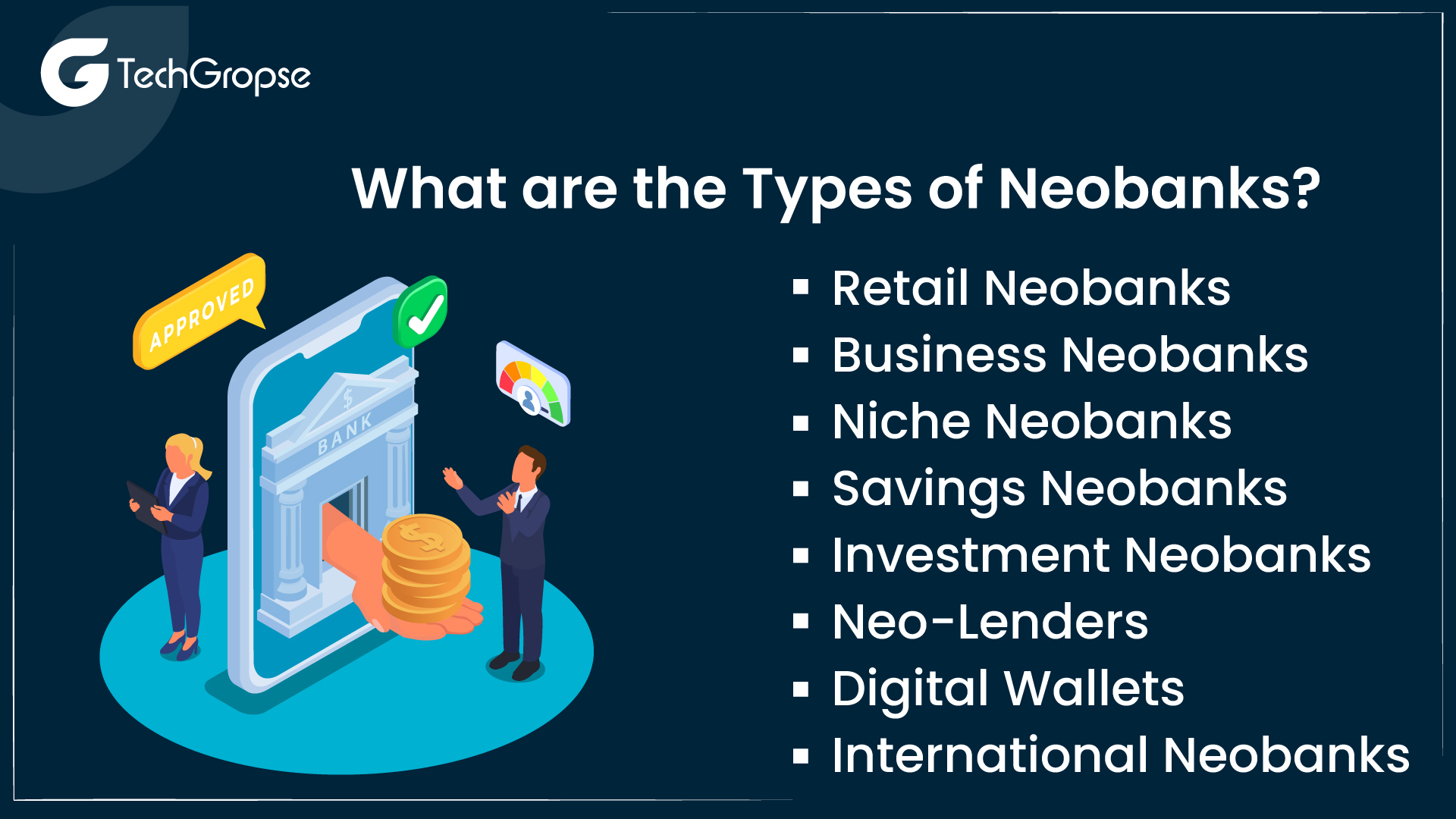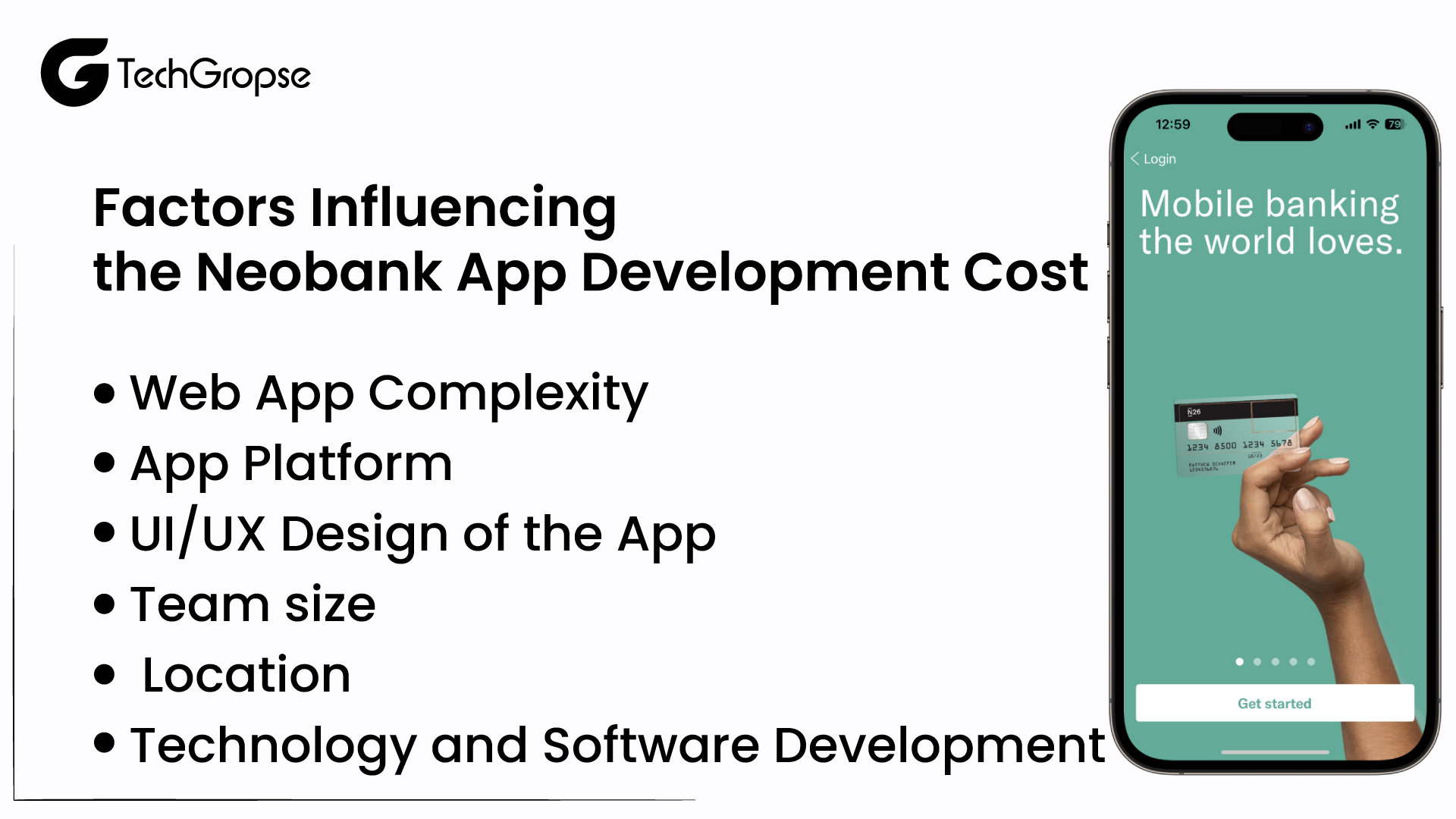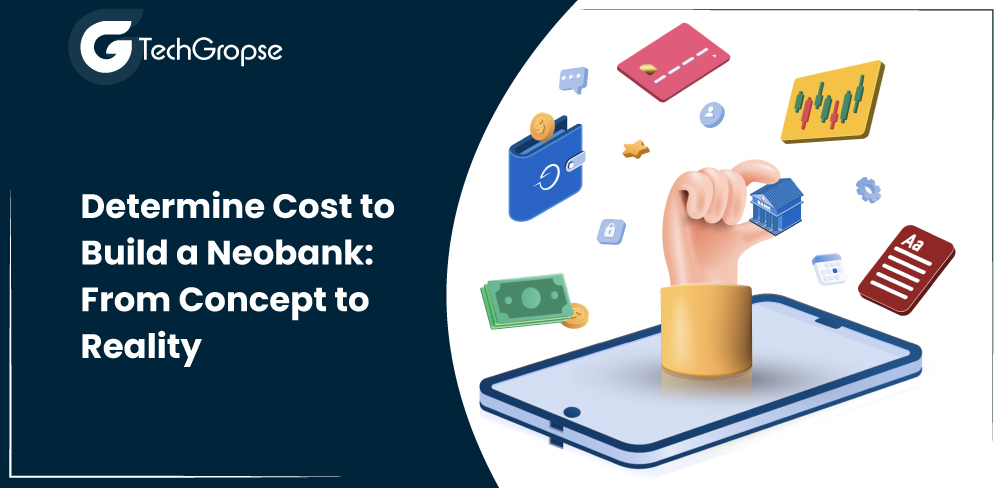“In the world of neo-banking, invention comes at an expense. The cost to build a Neobank reflects the ambition to redefine traditional banking, making it more accessible and customer-centric.”
There is been a big wave of money going into mobile banking app development, which is all about using technology to make banking better. One cool thing that’s happening is the rise of neobanks. These are digital banks that offer really innovative ways to do your banking.
Neobanks, also known as digital banks or virtual banks, have been emerging as disruptive players in the financial industry. If you plan to build a Neobank you should know their innovative technology-driven approach.
Neobanks aims to provide seamless and user-friendly banking experiences to customers. Instead, they do everything through mobile apps and software. But don’t worry, they still offer all the regular banking services like putting money in, taking money out, getting loans, and even investing.
The best part is that Neobank development company makes everything super easy and convenient for you with their modern digital system. So, you can do all your banking things right from your smartphone.
You see, a lot of banks are old-fashioned and have physical buildings you have to go to. They charge more money for their services and don’t always make it easy for customers. That is where neobanks come in.
So if you are someone who thinks it would be awesome to have a bank that is all digital and super high-tech or want to build a Neobank then you are going to love reading this.
What is Neobanks and Their Growing Popularity
Neobanks, the digital-only banks built on inventive technology and user-friendly interfaces, have been achieving tremendous popularity in recent years.
With their smooth processes and customer-centric approach, neobanks aim to challenge the traditional banking model. As more and more individuals seek convenience and personalized banking experiences, the demand for neobanks continues to rise.
As traditional banks face mounting pressure to adapt to the digital age, neobanks have gained significant traction among consumers seeking convenient, accessible, and personalized financial services.
However, one burning question for aspiring neobank founders remains: How much does it cost to build a neobank?
Let’s move into the factors that influence the mobile app development cost and achieve a better understanding of the financial implications involved.
Determine Current Neobanking App Development Trends
- According to Statista, the value of neobanking solutions is going to be a whopping $4.74 trillion by the year 2023.
- By the end of 2024, around 30% of those big banks that make a ton of money are planning to introduce something called BaaS, which stands for “Banking As a Streamlined Service.”
- According to the Grand View Research, the Neobanking market was worth about $66.82 billion in 2022. And it is expected to grow at a rate of 54.8% every year from 2023 to 2030.
- As per Reportlinker.com, the global neobanking market is going to keep on growing. It’s predicted to be worth $78.02 billion in 2022, and by 2026, it’s going to reach a whopping $359.46 billion.
So, there you have it lot of data to build a Neobank. Well, Neobanking is on the rise, and it is going to be a big deal in the future. Who knows, maybe one day you will be using neobanks to manage your money too.
Know the Difference Between a Neobank & a Traditional Bank?
So, are you ready to build an app like Neobank? You should know that Neobanks and traditional banks differ in several key ways, primarily related to their business models, technology, and customer experience:
| Aspect | Traditional Banks | Neobanks |
| Ownership and Regulation | Established institutions, heavily regulated | Often partner with traditional banks or use their licenses, subject to regulations |
| Physical Presence | Physical branches for in-person services | Digital-only, no physical branches |
| Cost Structure | Higher operating costs due to physical presence | Lower overhead costs due to digital-only operations, potentially lower fees |
| Customer Experience | Offer a wide range of services, including loans, mortgages, investments | Focus on user-friendly digital experience, specialized features like budgeting tools |
| Innovation and Technology | May have legacy systems, slower innovation | Built on modern technology, faster innovation, integration with fintech solutions |
| Accessibility | Offer both physical and digital banking options | Primarily digital services, may not suit all customer preferences |
| Geographical Reach | Broad geographical presence | May be limited in geographical coverage |
| Customer Base | Serve diverse customer segments | Tend to target specific customer niches |
| Account Opening | May require in-person visits and paperwork | Offer streamlined digital account opening |
| Service Options | Full suite of financial services | Focus on core banking services, may expand into niche offerings |
What are the Types of Neobanks?

Neobanks, also known as digital banks or challenger banks, come in various types, each with its own focus and target audience.
Here are some common types of Neobanks:
- Retail Neobanks: These neobanks cater to individual consumers and offer a range of retail banking services, including payment services, checking and savings accounts, and budgeting tools.
- Business Neobanks: Business-focused neobanks provide banking services tailored to the needs of small and medium-sized enterprises and startups. They may offer business accounts, invoicing tools, and expense management features.
- Niche Neobanks: Niche neobanks focus on serving specific demographics or industries. For example, there are neobanks designed for freelancers, gig workers, immigrants, or students, each offering specialized services.
- Savings Neobanks: These neobanks specialize in high-yield savings accounts and financial products designed to help customers save and invest their money more effectively.
- Investment Neobanks: Some neobanks focus on investment services, offering features like robo-advisors, stock trading, and access to investment portfolios.
- Neo-Lenders: These neobanks combine banking services with lending, providing personal loans, credit lines, or peer-to-peer lending platforms.
- Digital Wallets: While not traditional banks, digital wallet providers like PayPal and Square Cash offer financial services like sending and receiving money, making payments, and even investing.
- International Neobanks: These neobanks are designed for travelers and expatriates, offering multi-currency accounts, no foreign transaction fees, and international money transfers.
How do Neobanks Make Money?
Neobanks, like traditional banks, generate revenue through various channels, although their strategies may differ due to their digital and often fee-focused approach.
Here are some common ways neobanks make money:
- Transaction Fees: Neobanks may charge transaction fees for specific services, such as international money transfers, ATM withdrawals exceeding a certain limit, or expedited fund transfers.
- Interchange Fees: Neobanks earn a percentage of each transaction made using their debit cards through interchange fees, which are paid by merchants to the bank that issues the card.
- Deposit Account Fees: Some neobanks charge fees for certain types of deposit accounts or services, such as premium accounts with added features or overdraft protection.
- Subscription Models: Many neobanks offer premium subscription plans with additional benefits, such as higher interest rates, reduced fees, or access to premium customer support. These subscriptions generate recurring monthly or annual revenue.
- Lending Services: Neobanks may offer personal loans, credit lines, or other lending products. They generate revenue through the interest and fees associated with these loans.
- Investment Services: Neobanks that offer investment options, such as robo-advisory services or access to stock trading, can earn fees based on assets under management (AUM) or transaction fees for each trade.
- Partnerships and Referral Fees: Neobanks often collaborate with fintech companies and service providers. They can earn referral fees or commissions when users sign up for third-party services through their platform.
- Overdraft and Late Payment Fees: While some neobanks focus on avoiding overdraft fees, others may charge fees for overdrawing an account or making late loan payments.
- Advertising and Promotions: Neobanks can partner with businesses for targeted advertising or promotional offers within their apps. These partnerships may provide additional revenue.
- Data Monetization: Neobanks may analyze user data to offer personalized financial insights or to generate insights for third-party financial institutions, earning fees in the process.
What is the Estimate Cost to Build a Neobank?
Mobile banking app development cost can be significant work, and the cost can vary significantly based on several factors, including the features, technology stack, regulatory compliance, and geographic location of the development.
Below is an estimated cost breakdown below:
| Expense Category | Estimated Cost Range |
| Market Research and Planning | $5,000 – $10,000+ |
| Legal and Regulatory | $10,000 – $15,000+ |
| Technology Infrastructure | $20,000 – $30,000+ |
| Mobile and Web App Development | $30,000 – $50,000+ |
| Compliance and Licensing | $10,000 – $20,000+ |
| User Experience and Design | $10,000 – $15,000+ |
| Security and Data Protection | $20,000 – $30,000+ |
| Payment Integration | $30,000 – $50,000+ |
| Customer Support | $10,000 – $30,000+ |
| Marketing and Promotion | $10,000 – $20,000+ |
| Contingency (10% of total) | $100,000 – $500,000+ |
| Total Estimated Cost | $100,000 – $200,000+ |
Factors Influencing the Neobank App Development Cost

All these figures are rough estimates and can vary significantly based on factors like the scope of services, regulatory requirements, technology choices, and geographic location.
The cost can be substantially higher for neobanks with advanced features or those operating in multiple regions. If you want to build a Neobank you must consult with an ideal mobile app development company for accurate results.
Additionally, ongoing operational costs, compliance, and marketing expenses should be considered for long-term sustainability.
1. Web App Complexity
How hard and fancy a FinTech mobile app is can change how much money it takes to make it. Like, if you want to make a Neobank app that does a ton of impassive things and is really complicated, it’s gonna cost a lot more than making a Neobank app that only does a few basic things. You can hire dedicated developers to build a Neobank.
Check out these estimated costs for building a neobank at different levels of difficulty:
| Neobank App Type | Estimated Average Cost | Time Frame |
| Simple | $40,000 to $60,000 | 3 to 6 months |
| Moderately Complex | $60,000 to $100,000 | 6 to 8 months |
| Highly Complex | $100,000 to $250,000+ | 9+ months |
2. App Platform
The type of app platform you choose affects how much it costs to make a Neobank. If you want to make an app for iPhones or Android phones, it will cost different amounts of money depending on things like how long it takes to make and test the app.
To save money, it’s a good idea to start with just one platform at first. Once your app becomes famous, you can make it work on both types of mobile phones.
3. UI/UX Design of the App
Neobanks primarily interacts with customers through mobile and web applications. Designing and developing user-friendly, secure, and feature-rich applications requires expertise and investment. You have to hire Android app developers and investing in robust software frameworks is necessary to ensure a seamless user experience across various devices.
Aspects that influence the cost of UI/UX design of the Neobank app include:
- Content writing
- Button placements
- Branding
- UI optimization
- Portrait or landscape mode
- Visual elements
- Typography
- Color psychology
4. Team size
How many people work on making an app is super important when figuring out how much it will cost to make a Neobank app. If you hire freelancers, it might be cheaper, but the app might not be as good because they might not know everything.
On the other hand, if you give the project to a special mobile banking app development company, it could save money and they will know a lot because they have been doing it for a long time.
| Role | Simple Neobank App | Moderately Complex Neobank App | Highly Complex Neobank App |
| Product Manager | 1 | 1 | 1 |
| Project Manager | 1 | 1 | 1 |
| Business Analyst | 1 | 1 | 1 |
| UI/UX Designer | 1 | 2 | 2 |
| Front-end Developer | 1-2 | 2-3 | 3-4 |
| Back-end Developer | 1-2 | 2-3 | 3-4 |
| Mobile App Developer | 1-2 | 2-3 | 3-4 |
| Quality Assurance (QA) | 1 | 1-2 | 2-3 |
| DevOps Engineer | 1 | 1 | 1-2 |
| Security Specialist | 1 | 1 | 1-2 |
5. Location of the Mobile Banking App Development Company
Where the Neobank development company is located can also change how much money it costs to make. It is important to know that the price for each hour of development work is cheaper in places like Asia or Europe compared to the UK, UAE, or the US.
Here are some estimated prices for each hour of development work in different regions:
| Region | Estimated Hourly Rate Range |
| North America (US/Canada) | $100 – $200+ |
| Western Europe | $80 – $150+ |
| Eastern Europe | $40 – $100+ |
| Asia (e.g., India) | $25 – $60+ |
| Latin America | $30 – $70+ |
| Middle East/Africa | $30 – $70+ |
| Oceania (Australia/New Zealand) | $80 – $150+ |
6. Technology and Software Development
The heart of any neobank lies in its core banking system. This system powers the entire banking infrastructure, including transaction processing, account management, and data management. Developing or partnering with a reliable core banking system provider is a substantial investment for building a Neobank.
| Layer/Component | Estimated Price Range |
| Front-end Development | – React Native or Flutter |
| – React.js or Angular | |
| Back-end Development | – Node.js, Python, Java, Go |
| Database | – PostgreSQL, MySQL, MariaDB |
| – MongoDB, Cassandra, Redis | |
| Cloud Hosting | – AWS, Azure, GCP: Costs vary based on usage and resources. The budget for hosting services can range from $1,000 to $10,000+ per month depending on traffic and scaling needs. |
| APIs and Integrations | – Third-party API access: Costs vary based on the number and type of APIs used, ranging from $0 to several thousand dollars per month. |
| Security | – Security tools and audits: The budget for security tools and audits can range from $10,000 to $50,000+ depending on complexity. |
| Compliance and Regulations | – Regulatory compliance tools and services: Costs can vary significantly based on location and specific regulatory requirements, ranging from $5,000 to $50,000+ annually. |
| Mobile App Security | – Code obfuscation, app hardening: Costs can range from $5,000 to $20,000+ for security measures. |
| DevOps and CI/CD | – CI/CD tools and infrastructure: Costs for CI/CD tools and infrastructure can range from $1,000 to $5,000+ per month. |
| Monitoring and Analytics | – APM tools, log management: Costs can vary from $500 to $2,000+ per month based on usage. |
| Customer Support | – Chatbots, helpdesk software: Costs for chatbot development and helpdesk software can range from $5,000 to $20,000+ annually. |
| Scalability | – Load balancing, microservices: Costs can vary based on architectural choices, typically ranging from $10,000 to $50,000+ for scalability measures. |
| Testing | – Testing tools and services: Depending on testing complexity, costs can range from $2,000 to $10,000+. |
| Data Analytics | – Data warehousing, analytics platforms: Costs can range from $1,000 to $10,000+ per month based on usage. |
| Total Estimated Technology Stack Costs | A rough total budget for the technology stack can range from $50,000 to $500,000+ or more, depending on project size and complexity. |
How to Start a Neobank?
Every step is essential to build a Neobank and launching a successful Neobank. It’s important to seek expert advice, stay informed about financial regulations, and prioritize customer trust and satisfaction throughout the process.
Here is a summarized guide on how to start a Neobank presented below:
| Step | Description |
| 1. Market Research and Business Plan | – Identify target audience and competition.
– Develop a comprehensive business plan. |
| 2. Legal and Regulatory Compliance | – Choose a favorable jurisdiction.
– Consult legal experts for regulatory compliance. |
| 3. Capitalization | – Secure initial capital for development and operations.
– Explore funding options (VC, angel investors, crowdfunding). |
| 4. Technology Stack | – Partner with a mobile banking app development team.
– Develop secure, user-friendly mobile and web apps. |
| 5. Banking Infrastructure | – Partner with an existing bank or obtain a banking license (if required).
– Set up financial infrastructure. |
| 6. Products and Services | – Define the range of financial products and services.
– Design innovative features and user experiences. |
| 7. Customer Acquisition and Marketing | – Develop a marketing strategy.
– Use digital channels and partnerships for user acquisition. |
| 8. Compliance and Risk Management | – Establish strict compliance and risk protocols.
– Implement KYC, AML, and fraud prevention. |
| 9. Customer Support and Service | – Set up customer support channels.
– Provide excellent customer service. |
| 10. Launch and Iterate | – Soft launch to gather feedback and identify issues.
– Continuously improve products and services. |
| 11. Scaling and Growth | – Focus on scaling operations and expanding the customer base.
– Explore additional revenue streams. |
| 12. Ongoing Compliance | – Stay updated with evolving financial regulations.
– Ensure ongoing regulatory compliance. |
Let’s Start to Build a Neobank App
Well to build a Neobank needs careful consideration of different factors that influence the associated costs. From developing robust technological infrastructure to obtaining necessary licenses and building a talented team, the expenses can vary significantly depending on the scale and scope of services offered.
Additionally, effective marketing strategies and ongoing maintenance are crucial for success in this competitive industry. By examining successful case studies, aspiring neobank builders can gain valuable insights and learn from the experiences of established players.
As the demand for digital banking solutions continues to grow, understanding the cost dynamics to build a Neobank will be vital for those seeking to enter this exciting and disruptive space.
FAQ: How Much Does it Cost to Build a Neobank
1. How to start your own Neobank?
To start your own neobank, conduct market research, secure capital, ensure regulatory compliance, build a user-friendly tech stack, define services, acquire customers through marketing, implement robust compliance and security measures, provide excellent customer support, and continuously iterate and scale your operations. Collaboration with experts is crucial for success.
2. How profitable are Neobanks?
Neobanks have the potential for profitability through fees, interest income, and partnerships. However, achieving profitability often takes time due to initial investments in technology and compliance. Success depends on scaling customer acquisition, maintaining low operational costs, and offering compelling financial products and services.










